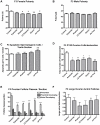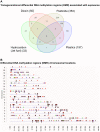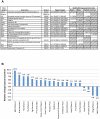Transgenerational actions of environmental compounds on reproductive disease and identification of epigenetic biomarkers of ancestral exposures
- PMID: 22389676
- PMCID: PMC3289630
- DOI: 10.1371/journal.pone.0031901
Transgenerational actions of environmental compounds on reproductive disease and identification of epigenetic biomarkers of ancestral exposures
Abstract
Environmental factors during fetal development can induce a permanent epigenetic change in the germ line (sperm) that then transmits epigenetic transgenerational inheritance of adult-onset disease in the absence of any subsequent exposure. The epigenetic transgenerational actions of various environmental compounds and relevant mixtures were investigated with the use of a pesticide mixture (permethrin and insect repellant DEET), a plastic mixture (bisphenol A and phthalates), dioxin (TCDD) and a hydrocarbon mixture (jet fuel, JP8). After transient exposure of F0 gestating female rats during the period of embryonic gonadal sex determination, the subsequent F1-F3 generations were obtained in the absence of any environmental exposure. The effects on the F1, F2 and F3 generations pubertal onset and gonadal function were assessed. The plastics, dioxin and jet fuel were found to promote early-onset female puberty transgenerationally (F3 generation). Spermatogenic cell apoptosis was affected transgenerationally. Ovarian primordial follicle pool size was significantly decreased with all treatments transgenerationally. Differential DNA methylation of the F3 generation sperm promoter epigenome was examined. Differential DNA methylation regions (DMR) were identified in the sperm of all exposure lineage males and found to be consistent within a specific exposure lineage, but different between the exposures. Several genomic features of the DMR, such as low density CpG content, were identified. Exposure-specific epigenetic biomarkers were identified that may allow for the assessment of ancestral environmental exposures associated with adult onset disease.
Conflict of interest statement
Figures





References
-
- Kavlock R, Cummings A. Mode of action: inhibition of androgen receptor function–vinclozolin-induced malformations in reproductive development. Crit Rev Toxicol. 2005;35:721–726. - PubMed
Publication types
MeSH terms
Substances
Grants and funding
LinkOut - more resources
Full Text Sources
Other Literature Sources
Molecular Biology Databases
Miscellaneous

